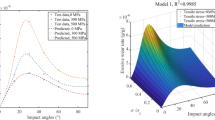Abstract
In order to optimize the performance and prolong the service life of the concrete material used in the dam, the corrosion evolution of the concrete material used in the dam was analyzed. Using FLUENT programming function, the concrete corrosion model of dam is established. The relevant parameters of the porous media model were obtained by the user defined function (UDF) module of FLUENT. Using polycarboxylic acid molecular structure to control the corrosion of concrete under the action of reservoir dissolution, a numerical simulation test was designed and the evolution process of concrete corrosion was analyzed. Mettler Toledo pH Meter was used to determine the pH value of the water sample. Water with different pH values was used as an accelerated condition for concrete dissolution. The experiment lasted for 30 days. The experimental results show that the material and concrete base plate treated by this method have good compactness, thus prolonging the life of concrete material.









Similar content being viewed by others
References
Balestra CET, Nakano AY, Savaris G, Medeiros-Junior RA (2019) Reinforcement corrosion risk of marine concrete structures evaluated through electrical resistivity: proposal of parameters based on field structures. Ocean Eng 187:106167
Bartelmess J, Zimmek D, Bartholmai M, Strangfeld C, Schferling M (2020) Fibre optic ratiometric fluorescence pH sensor for monitoring corrosion in concrete. Analyst 145:2111–2117
Boinski F, Hullebusch EV, Chatellier P, Chaussadent T (2009) Study of the mechanisms of biodegradation of concrete materials for a better durability of the sewer systems. Z Für Die Gesamte Hyg Und Ihre Grenzgeb 13(7):487–93
Cao L (2020) Changing port governance model: port spatial structure and trade efficiency. J Coastal Res 95(sp1):963
Chi J, Zhang G, Xie Q, Ma C (2019) High performance epoxy coating with cross-linkable solvent via Diels-Alder reaction for anti-corrosion of concrete. Prog Org Coatings 139:105473
Hossain KMA, Hossain MA, Manzur T (2020) Performance of engineered cementitious composite covered or wrapped self-consolidating concrete beams under corrosion. Eng Struct 219:110801
Kaethler CB, Angst UM, Aguilar AM, Elsener B (2019) A systematic data collection on chloride-induced steel corrosion in concrete to improve service life modelling and towards understanding corrosion initiation. Corrosion Sci 157(AUG):331–336
Li X, Khademi F, Liu Y, Akbari M (2019a) Evaluation of data-driven models for predicting the service life of concrete sewer pipes subjected to corrosion. J Environ Manag 234:431–439
Li X, O'Moore L, Song Y, Philp LB, Yuan Z, Wilkieac S et al (2019b) The rapid chemically induced corrosion of concrete sewers at high H2S concentration. Water Res 162(OCT.1):95–104
Liao Q, Wei W, Zuo H et al (2020) Interfacial bonding enhancement and properties improvement of carbon/copper composites based on nickel doping. Composite Interfaces 2:1–13
Liu C, Huang X, Wu Y et al (2020) Review on the research progress of cement-based and geopolymer materials modified by graphene and graphene oxide. Nanotechnol Rev (Berlin) 9(1):155–169
Lu YY, Hu JY, Li S, Tang WS (2018) Active and passive protection of steel reinforcement in concrete column using carbon fibre reinforced polymer against corrosion. Electrochimica Acta 278:124–136
Mohammed EA, Refai UE, Antonio N (2018) Experimental results and modelling of corrosion-damaged concrete beams strengthened with externally-bonded composites. Eng Struct 172:172
Sassolini A, Colozza N, Papa E, Hermansson K (2019) Screen-printed electrode as a cost-effective and miniaturized analytical tool for corrosion monitoring of reinforced concrete. Electrochem Commun 98:69–72
Song Y, Li X, Wei J, Zhang H (2019) Distinct microbially induced concrete corrosion at the tidal region of reinforced concrete sewers. Water Res 150(MAR.1):392–402
Yoon IS, Shin H, Kang HK (2019) Comparative study on performance of corrosion protective systems for post-tensioned concrete members. ACI Struct J 116(3):273–284
Yu H, Dai W, Qian G et al (2020a) The NOx degradation performance of nano-TiO2 coating for asphalt pavement. Nanomaterials (Basel, Switzerland) 10(5):897
Yu H, Zhu X, Qian G, Gong X, Nie X (2020b) Evaluation of phosphorus slag (PS) content and particle size on the performance modification effect of asphalt. Constr Build Mater 256:119334
Zeng L, Chen G, Chen H (2020) Comparative study on flow-accelerated corrosion and erosion-corrosion at a 90° carbon steel bend. Materials (Basel, Switzerland) 13(7):1780
Zhou Y, Hao C, Dang Y, Chen S (2018) Study on Electrocatalysis of environmental hormone BPA based on fluent-electron-transfer Ce-doped ZnO nanorods. J Electrochem Soc 165(14):H962–H968
Zhu X, Meng Z, Liu L, Xu L (2019) An equivalent smeared layer method for simulating the non-uniform corrosion-induced damage of concrete. Eng Fracture Mech 224:106791
Author information
Authors and Affiliations
Corresponding author
Ethics declarations
Conflict of interest
The authors declare that they have no competing interests.
Additional information
Responsible Editor: Keda Cai
This article is part of the Topical Collection on Geological Modeling and Geospatial Data Analysis
Rights and permissions
About this article
Cite this article
Zhang, X., Gao, C. & Sun, Y. Reliability analysis and numerical simulation of concrete reservoir dam discharge flow based on aging. Arab J Geosci 14, 697 (2021). https://doi.org/10.1007/s12517-021-07016-3
Received:
Accepted:
Published:
DOI: https://doi.org/10.1007/s12517-021-07016-3




